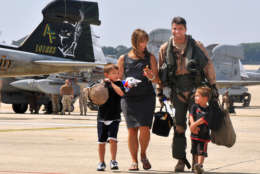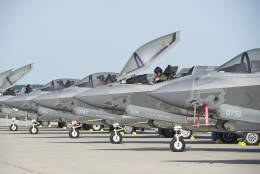Defense
-
The Senate defense authorization bill increases the Army's active duty end strength by 5,000. It also creates a policy for responding to cyber attacks.
June 29, 2017 -
The House Armed Services Committee voted Wednesday to carve out the Air Force's current space missions and turn them over to a new U.S. Space Corps. But several members objected, saying the full committee has never even held a hearing on the issue.
June 29, 2017 -
The House defense authorization bill brought up some important issues for those in the military and their loved ones. Find out what could affect you in the coming year.
June 29, 2017 -
Air Force brass say they want more planes and pilots. Congress proposed developing a new U.S. Space Corps. Air Force Secretary Heather Wilson said she's interested in the idea because it would add complexity and cost. What exactly did the House propose and who's behind it? Rob Levinson, senior defense analyst at Bloomberg, joined Federal Drive with Tom Temin to discuss the answer.
June 29, 2017 -
There’s an acronym used by federal leaders in the business of preventing or responding to Chemical, Biological, Radiological, Nuclear and Explosive attacks: VUCA. It stands for “volatile, uncertain, complex and ambiguous,” it describes the CBRNE operational environment, and they agree that it’s only getting more apt.
June 28, 2017 -
Insider Threat programs across all agencies must develop alongside technology, the GAO reports. However, the Department of Defense is making significant progress.
June 28, 2017 -
The Defense Information Systems Agency is hard at work on the next generation of mobile, secure computing for the Defense Department. And it's up to some heavy contracting activity.
June 27, 2017 -
Former Defense Secretary Robert Gates once said that for too many Americans, military service is something for others to do — but a trend has been building ever since institution of the all-volunteer force. Enlistees come from a shrinking number of locations, and more and more come from families from which someone else has served. James Winnefeld, a Navy Admiral and former vice chairman of the Joint Chiefs of Staff, joined Federal Drive with Tom Temin to discuss problems this may cause and some possible solutions.
June 27, 2017 -
Camron Gorguinpour, principal at Woden, joins host John Gilroy on this week's Federal Tech Talk to discuss innovation, open systems architecture and how his company helps organizations gain a new perspective on diversity and defense acquisition. June 27, 2017
June 26, 2017 -
House Armed Services Committee Chairman Mac Thornberry said he wouldn't back down from the $640 billion defense top-line in the NDAA unless a multi-year budget deal could be reached. But then he backed down from the $640 billion top-line.
June 26, 2017 -
Since 1951, the Defense Advisory Committee on Women in the Services — the armed services, that is — has forwarded its annual research findings to the Defense Secretary. This year the committee has sent up fourteen recommendations.
June 26, 2017 -
The Navy has removed almost all of its departmentwide computer-based training requirements for both sailors and civilians, in favor of more local control by commands. The Air Force has cut its servicewide online training demands in half, with more reductions possibly on the way.
June 26, 2017 -
The idea of an Amazon-like market is the latest iteration of a durable idea, namely getting the government to buy commercial items in a commercial way.
June 23, 2017 -
The Air Force is giving battlefield airmen incentive pay even when they are not in a war zone to encourage them to seek medical care and stay in the service.
June 22, 2017 -
A House panel wants to give military spouses up to $500 to get relicensed in their occupations after station changes in order to make relocation easier on families.
June 22, 2017















